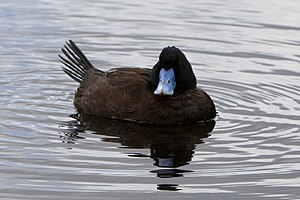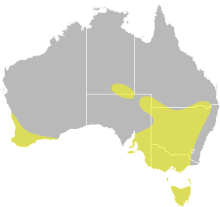Blue-billed duck
| Blue-billed duck | |
|---|---|
 |
|
| Scientific classification | |
| Kingdom: | Animalia |
| Phylum: | Chordata |
| Class: | Aves |
| Order: | Anseriformes |
| Family: | Anatidae |
| Subfamily: | Oxyurinae |
| Genus: | Oxyura |
| Species: | O. australis |
| Binomial name | |
|
Oxyura australis (Gould, 1836) |
|
 |
|
| Range of Oxyura australis | |
The blue-billed duck (Oxyura australis) is a small Australian stiff-tailed duck, with both the male and female growing to a length of 40 cm (16 in). The male has a slate-blue bill which changes to bright-blue during the breeding season, hence the duck’s common name. The male has deep chestnut plumage during breeding season, reverting to a dark grey. The female retains black plumage with brown tips all year round. The duck is endemic to Australia's temperate regions, inhabiting natural inland wetlands and also artificial wetlands, such as sewage ponds, in large numbers. It can be difficult to observe due to its cryptic nature during its breeding season through autumn and winter. The male duck exhibits a complex mating ritual. The blue-billed duck is omnivorous, with a preference for small aquatic invertebrates. BirdLife International has classified this species as Near Threatened. Major threats include drainage of deep permanent wetlands, or their degradation as a result of introduced fish, peripheral cattle grazing, salinization, and lowering of ground water.
The blue-billed duck was described in 1836 by ornithologist John Gould. The specific name australis is derived from the Latin for "southern", hence Australian, while the generic name is derived from the Latin oxy- "sharp" and ura "tail".
The tail feathers for both the male and female are made up of thick, spine-like shafts. The tail is usually held flat on the surface of the water, or held erect when defensive. The male also holds the tail erect during courtship displays. The feet are quite powerful, which aids in swimming and diving. The duck sits low in the water in comparison to other ducks. During breeding season, apart from the aforementioned bright-blue bill, the male's head and neck are glossy black, and the back and wings are a rich chestnut. During the nonbreeding season, the head changes from its glossy black to black with grey speckles, and its body changes from chestnut to dark grey. Some males retain breeding plumage throughout the year. The female’s plumage does not change throughout the year. Its head is dark brown, and the back and wings consist of black feathers with a light-brown tip, giving a mottled appearance, although the National Parks and Wildlife publication on O. australis refers to bands on each feather rather than a single feather-tip colouration. The female's bill is dark grey-brown, and its feet are grey-brown, while the male’s feet are grey. Both sexes have brown irises. Immature blue-billed ducks resemble the adult female, though paler with a grey-green bill.
...
Wikipedia

